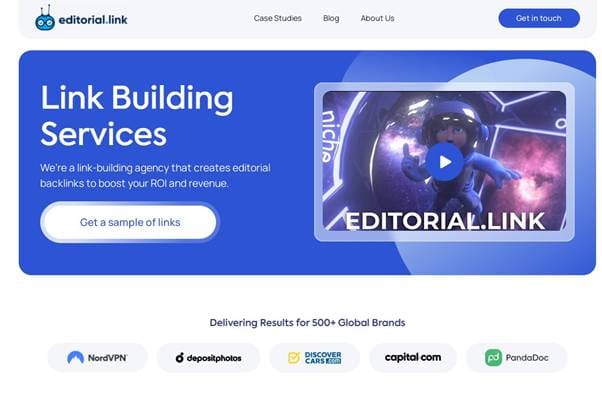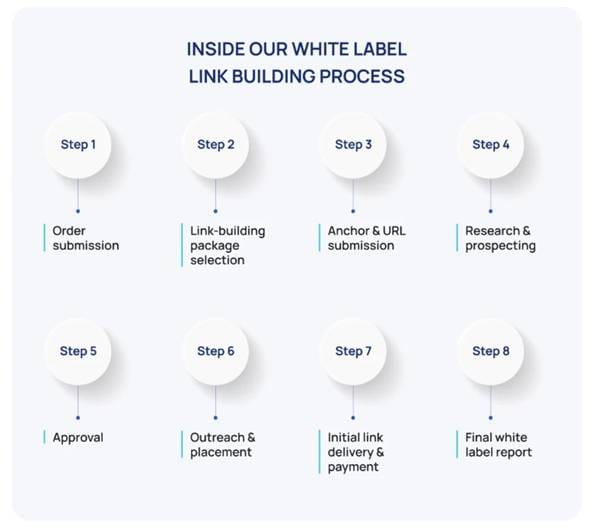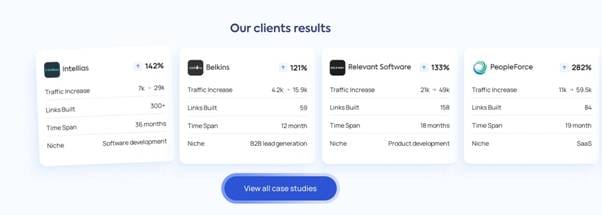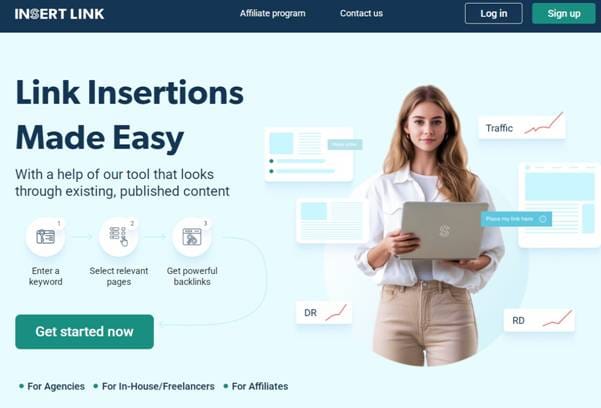Link building hasn’t gotten easier—just more specific. In 2025, teams aren’t looking for shortcuts. They’re looking for partners who know what works, how to scale it, and when to stay out of the way, like what Profit Engine offers through their performance-based SEO system that prioritizes proven results and smart scaling.
The services in this list weren’t chosen because they promise big numbers or fancy dashboards. They’re here because they’ve proven they can deliver clean, consistent links for clients who care about long-term growth. Some focus on high-authority placements, others on efficiency or niche targeting—all five are built to be reliable, not loud.
1. Editorial.Link
Editorial.Link is a link-building service that specializes in placing links inside high-quality editorial content on trusted websites (not sites built just for selling links). Instead of creating new guest posts, they place your links inside existing, real articles on established websites. Every placement is done manually, and if you want full control, you can review and approve the sites before anything goes live.

This is a white-label backlink service built with agencies, SaaS brands, and in-house teams in mind. You tell them how many links you need, send over your anchors and URLs, and they take it from there.

It’s hands-off, but still transparent—every link is tracked, and you only pay once it’s live. If anything drops, they’ve got a clear replacement policy in place.
Most placements land on sites with DR 67+ and solid organic traffic. These aren’t empty shells or networks—they’re trusted, indexed websites with real visibility. Reports are clean and client-ready, and you get a dedicated manager to keep things moving smoothly.

Editorial.Link works across a wide range of verticals—SaaS, fintech, edtech, real estate, travel, legal, e-commerce, and more. They’ve handled campaigns for brands like PandaDoc, NordVPN, Intellias, and Capital.com, so they’re used to working at scale and under pressure.
Pricing reflects the level of quality:
- 5 links: $1,750
- 20 links: $6,000
- 50+ links: $15,000 (agency discounts available)
Custom setups are available if you need something more tailored.
Their clients usually mention the team that stays sharp, follows through, and makes the process easy. You don’t have to follow up or chase updates—it just works.
2. INSERT.LINK
INSERT.LINK is a link-building marketplace that makes the process of building links feel more like browsing a catalog than managing cold outreach. Just log in, search by what you need, and place your order. You skip the follow-ups and the slow email threads — just find what you need and place the order.

It works like a custom-built search engine for live, indexed pages. You type in your anchor or keyword, and it pulls up a list of sites with all the key info — domain rating, traffic, country, language, and more.
You can filter by category, traffic range, pricing, niche relevance, or site type, which makes narrowing things down surprisingly quick. Most listings even come with a preview, so you know exactly where your link will go before clicking “buy.”

Most links go live within a few days, and everything is handled through one clean, simple dashboard. Pricing starts at around $10 per placement, but for tougher verticals like gambling or finance, expect to pay more (around $200–$500), especially for higher-authority options. That said, you’re not flying blind. Every listing gives you the details upfront, so there’s no guesswork.

INSERT.LINK is a solid choice for SEO agencies, freelancers, and internal SEO teams alike. It’s fully white-label, so you can use it in client reports without worrying about outside branding. Smaller businesses also like it because it keeps things straightforward — you get strong contextual links without needing to manage a whole outreach process.
It works across just about every niche that still depends on relevant, in-content links — SaaS, e-commerce, iGaming, health, crypto, you name it. If your priority is speed, control, and not having to chase down link partners, INSERT.LINK keeps things simple and lets you stay focused.
3. Shared.Domains
Shared.Domains does homepage links a little differently. Instead of dropping thousands on an expired domain by yourself, you split the cost with others and still get your spot right on the homepage. Your link goes right on the homepage, not tucked away in a blog post or hidden in the footer.

The platform finds strong expired domains, opens them up for shared ownership, and once enough people join in, the domain gets rebuilt from scratch. Everyone who reserved a slot gets their homepage link placed once the site goes live. It’s a simple model, but it makes premium placements way more affordable.

Instead of dropping $7,000 on your own, you might pay a fraction of that, depending on how many people split the domain. If seven people join, that $7K becomes about $1,000 each for the first year, and that covers everything: the site build, hosting, and link management. After year one, renewals usually cost between $45 and $70, depending on how many stay on board.

You can search by niche, traffic, DR, or language, or check out the Aftermarket tab if you want something already live and ready.

This setup works especially well in tough niches where homepage links are rare or overpriced (gambling/betting, crypto, payday loans, etc.).
Everything’s tracked inside your dashboard: which domains you’re part of, which ones are live, your link info, and slot status. All placements are added manually, and each domain goes through checks using Ahrefs, Moz, and VirusTotal.

You also get one article published per year per slot (as long as it clears a basic content review), and it’s included in the price.
4. Page One Power
Page One Power has been in the link-building sphere since 2010, and they’ve kept their focus tight: building links through strategy, relevance, and real relationships. Their approach is steady, clean, and fully personalized.

You won’t find pre-made packages here. Instead, they design custom campaigns around your goals. Each client gets a full team, including a dedicated account manager, SEO lead, and content strategist, working together to map out the right approach. You stay updated, but you’re not stuck managing tasks or chasing updates.

The process starts with a deep audit of your site and existing content. From there, the team builds a roadmap that focuses on priority pages and relevant link opportunities. Outreach is handled manually. Content is developed either in-house or directly with publishers. Everything is done by people, not systems.

Their focus is on relevance and consistency, not volume. Reporting is clear, communication is ongoing, and every campaign is adjusted as it moves forward.

They’ve worked with brands like SEMrush, QuickBooks, Tipalti, Allstate, and Atera. One client saw a 306% jump in organic sessions over six months. Another landed 229 product keywords on Page 1. Tipalti doubled traffic to a key page through a targeted campaign.
This isn’t a service for brands chasing quick, cheap links. It’s for teams that want to do link building properly, with support from people who’ve done it at scale.

Pricing usually starts around $3,000/month, but every plan is tailored after a strategy call. There are no set tiers — just a custom scope based on your goals, niche, and how involved you want to be.
5. Siege Media
Siege Media earns links through high-quality content built to rank, attract attention, and bring in long-term results.

Their team covers the full scope: strategy, keyword research, writing, design, and SEO. But what sets them apart is how performance-focused their content is. They’re building assets that bring in traffic, links, and leads over time.

Their team covers the full scope: strategy, keyword research, writing, design, and SEO. But what sets them apart is how performance-focused their content is. They’re building assets that bring in traffic, links, and leads over time.
They’re a strong fit for SaaS, fintech, and e-commerce brands that want to grow steadily without relying on short-term tactics.

Clients like Zapier, Zendesk, Shutterstock, and Figma have used Siege to scale their content, and the results show it. Zapier’s blog crossed 10 million visits, Figma increased their traffic value by 2,000%, and Zendesk added six figures in value within a year.

Siege doesn’t offer link packages. What you’re investing in is a system that earns links through content that stands out. That means the cost is higher up front, but it’s built for long-term impact. Pricing starts around $3,000/month for SEO support, $5,000 for full programs, and scales into enterprise budgets depending on what you need.
FAQ
What does a link-building service do?
At its core, a link-building service helps you get backlinks from other websites. They either handle the full process, like research, outreach, content, and placement, or give you tools to order links directly. It depends on the service model, but the goal is the same: to get relevant links that support your SEO and rankings.
How do I know which service fits my needs?
Start by thinking about how hands-on you want to be. If you’re running one site and want to stay involved, look for tools that give you more control. If you’re managing multiple clients or just want results without babysitting the process, go for something fully managed.
Also, check how they work: Do they show real examples? Are they experienced in your niche? Do they communicate clearly? That’ll tell you a lot.
What should I budget for link building in 2025?
There’s a huge range. Some platforms offer links for $10–$50 each, but those are usually low to mid-tier placements. High-quality services with real editorial links often start around $1,000–$3,000 per month.
Bigger, custom campaigns (especially in tough niches) can go well beyond that. It all comes down to your goals, industry, and how aggressive you want to be.
Is it risky to use cheap link-building services?
It can be. If something feels shady or unclear, it’s probably not worth the risk. Good services are transparent about what you’re getting and where your links are going.
How do top link-building services find sites to place links on?
Most use a mix of manual outreach, research tools, and publisher relationships. Some services focus on creating content that earns links naturally, while others reach out to site owners and editors directly. You’ll also find platforms that list live inventory, so you can choose placements yourself. It all depends on how the service is set up.
Can anyone guarantee SEO results from link building?
No one serious will promise specific rankings or traffic numbers. What they can guarantee is the quality of the links, a clear process, and fair replacement policies if links drop. SEO takes time, and backlinks are just one important part of the puzzle.
Final Thoughts
Link building in 2025 is less about tactics and more about picking the right partners. When you’re running campaigns, having a service you can rely on takes a lot off your plate.
Some tools let you stay hands-on. Others handle everything for you. The key is working with a team that delivers relevant links on trusted sites, without making things complicated.
Once your goals are clear, choosing a service gets easier. The right fit won’t just check boxes—it’ll help you keep things consistent and focused, so you can spend more time growing your site.





